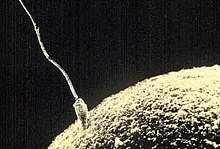
Oogamy is a form of anisogamy (heterogamy) in which the female gamete is significantly larger than the male gamete and non-motile (egg cell). The male gametes are typically highly motile spermatozoa competing for the fertilization of the immotile egg.
By contrast to isogamy, the gametes are specialized. The ovum contains nearly all of the materials that will be needed by the zygote after fertilization, but it typically cannot move. The sperm contains almost nothing but the male genetic contribution to the zygote, but it is usually tasked with all of the travel necessary to bring the respective gametes together. The prevalence of oogamy in higher animals leads to the conclusion that this specialization of the gametes results in their performing their respective tasks better and more efficiently than those tasks could be performed by generalist isogametes, particularly the ability to concentrate high-energy substances in a smaller number of ova.
Oogamy predominantly occurs in animals, but can also be found in many protists, certain orders of algae (Ochrophytes, Charophyceans), and some plants such as bryophytes, ferns, and some gymnosperms like cycads and ginkgo.
In some algae and most gymnosperms and all angiosperms, a variation of oogamy occurs where the sperm cells are non-motile as well.
See also